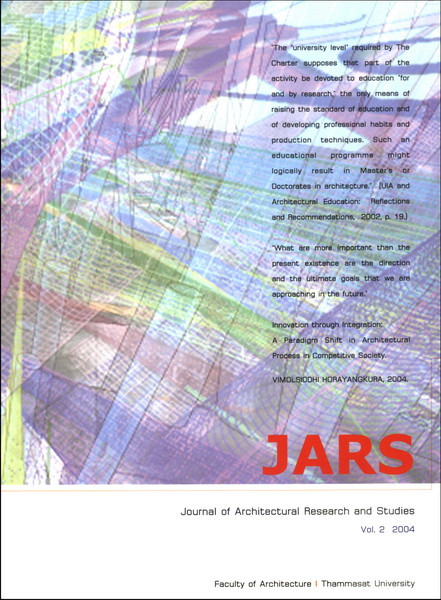Building Design Guidelines to Minimize Impacts from Terrorism
Main Article Content
Abstract
The word “Terrorism” used to be a foreign term to the people of Thailand. Today, however, globalization plus technology have driven everything closer together. Thus, terrorism should no longer be a stranger to us. Although there might not be as many terrorism incidents in Thailand as in some other countries, the possibilities of attack still remain a factor for architects and engineers when designing buildings. This article begins with the facts about terrorism. Then, a few ideas are presented to be used as guidelines for design professionals, when dealing with the new awareness of terrorism. Site and building planning, strengthening structure against impact, code compliance and the sub-office and the idea of decentralization are the main topics of discussion. The ideas are not meant to prevent acts of terrorism or to protect buildings entirely. Unfortunately, it is nearly impossible to prevent attacks. This article suggests that we, as design professionals, can find ways to minimize the impact of terrorist acts or discourage those acts altogether in order to protect ourselves and our property from becoming soft targets.
Downloads
Article Details

This work is licensed under a Creative Commons Attribution-NonCommercial-NoDerivatives 4.0 International License.
All material is licensed under the terms of the Creative Commons Attribution 4.0 International (CC-BY-NC-ND 4.0) License, unless otherwise stated. As such, authors are free to share, copy, and redistribute the material in any medium or format. The authors must give appropriate credit, provide a link to the license, and indicate if changes were made. The authors may do so in any reasonable manner, but not in any way that suggests the licensor endorses you or your use. The authors may not use the material for commercial purposes. If the authors remix, transform, or build upon the material, they may not distribute the modified material, unless permission is obtained from JARS. Final, accepted versions of the paper may be posted on third party repositories, provided appropriate acknowledgement to the original source is clearly noted.
References
“US Code Title 22, Section 2656f (d), Law Revision Counsel, US House of Representative http://www.uscode.house.gov/title22.html
JENKINS, Brian Michael; The future course of International Terrorism, The Futurist, July-August 1987.
Terrorism: An Introduction, Terrorism Q&A by U.S. Council on Foreign Relations http://www.terrorismanswers.com
Significant Terrorist Incidents, 1961-2001, Office of Historian, Bureau of Public Affair, U.S.Department of State http://www.state.gov
“Terrorism in Southeast Asia”, Department of the Parliament Library, Parliament of Australia http://www.aph.gov.au
Thailand’ s Terror, Time Asia, November 25, 2002, Vol.160 http://www.time.com
LUIF, Mary Lou; “Building codes stand tall against terrorism”, Southern Building, March/April 2002.
HAWKINS, Paula, “Design fault?”, Science & Engineering, December 2001.
How Building Implosions Work, Howstuffworks, Inc. http://www.howstuffworks.com
MENDIS, Priyan and NGO,Tuan, Concrete high-rise building subjected to blast loading and aircraft impact, University of Melbourne, Australia http://www.civag.unimelb.edu.au
“Internet users in Thailand”, National Electronics and Computer Technology Center (NECTEC), Ministry of Science,Technology and Environment, Thailand http://www.ntl.nectec.or.th


